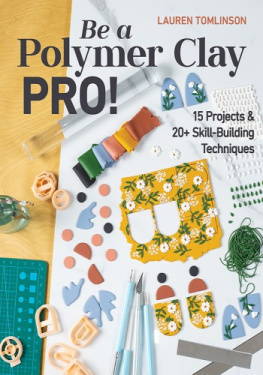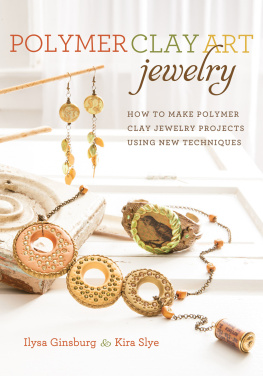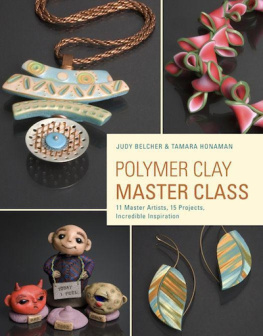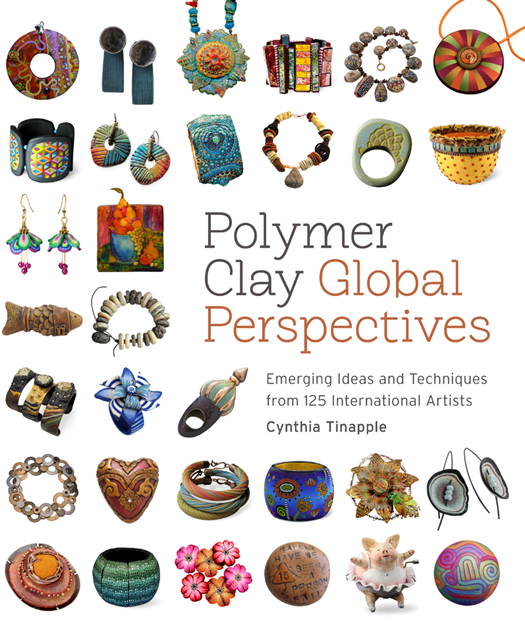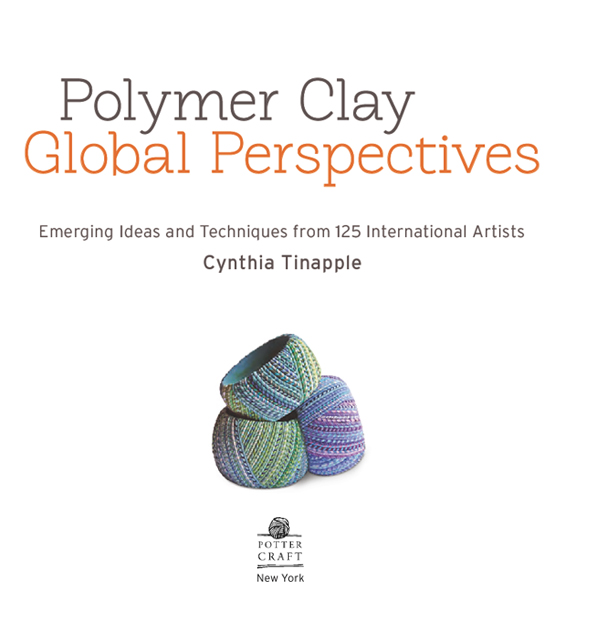Copyright 2013 by Cynthia Tinapple
All rights reserved.
Published in the United States by Potter Craft, an imprint of the Crown Publishing Group, a division of Random House, Inc., New York.
www.crownpublishing.com
www.pottercraft.com
POTTER CRAFT and colophon are registered trademarks of Random House, Inc.
Library of Congress Cataloging-in-Publication Data
Tinapple, Cynthia.
Polymer clay global perspectives : emerging ideas and techniques from 125 international artists / Cynthia Tinapple.
pages cm
Includes index.
1. Polymer clay craft. I. Title.
TT297.T56 2013
745.5723dc23
2012037060
Trade paperback ISBN 978-0-8230-8590-3
eBook ISBN: 978-0-8230-8591-0
Cover design by Jenny Kraemer
Cover photographs (front cover, top to bottom row, left to right): Cathy Barbaray, Genevieve Williamson, Christine Damm, Iris Mishly, Sabine Spiesser, Eva Haskova, Sandra Trachsel, Christine Damm, Tanya Mayorova, Linda Ezerman, Genevieve Williamson, Angie Wiggins, Kim Korringa, Gera Chandler, Rebecca Watkins, Genevieve Williamson, Donna Greenberg, Lisa Pavelka, Donna Kato, Louise Fischer-Cozzi, Tejae Floyde, Maria Belkomor, Larry Sanders, Christine Damm, Ellen Prophater, Annie Pennington, Bettina Welker, Marcia Tzigelnik, Danielle Chandler, Doreen Kassel, and Jan Montarsi
v3.1
Left: Maggie Maggio, Wrap Necklace ; polymer; 120 2 inches (305 5cm). Photograph by Courtney Frisse; modeled by Monica Maggio. Inspiration for this series was drawn from the neck rings worn by the Ndebele women of South Africa.
Center: Lynn Lunger, Botanical Collection Necklace ; polymer, ceramic washers, coconut shell, glass beads, and sterling silver; 17 inches long (43cm). Photograph by the artist. The circular beads are based on eucalyptus buds.
Right: Genevieve Williamson, Carved Rings ; polymer; 1 inches (3cm). Photograph by the artist. A solid block of polymer with the center removed makes for a seamless ring and a smooth surface for carving.
Juliya Lauhina, Green and Blue Twisted Bangles ; polymer; 3 2 inches (7.5 5cm). Photograph by the artist. This young Russian artist sells her wares at the Sunday market in Moscow.
Acknowledgments
This is the awkward moment when I mumble my thank-yous, staring at the floor and swallowing hard. I am overwhelmed with gratitude.
Judy Belcher made book writing sound like the logical next step. She nipped at my heels, herding my doubts and keeping me on the path. My editor, Caitlin Harpin, and the staff at Random House assumed that I knew everything that was happening in the polymer world, and I strived to keep up with their expectations. I stood on the sidelines as Maggie Maggio and Lindly Haunani produced their wonderful book, Polymer Clay Color Inspirations . They told me that the process was like childbirtha long gestation, the pain of delivery, and finally the joy of bringing an idea to life. Lindly told me when to push.
During the books gestation friends and family listened patientlyat the Tuesday night ladies Board of Directors meetings, at lunches with the McJam girls, during book club reviews, and at Saturday morning Breakfast Club confabs.
My daughter, Hillary, and I Skyped often and she gave honest feedback and gentle criticism. My son David and his wife, Tessa, continue to give me a glimpse into the world of fine art and academics. My sisters, Carol Lebeiko and Grace Christ, provided the therapy that only big sisters can supply. And I could always hear the voice of my late friend, Jan Crandell. I am glad that the early pieces of my polymer work that she loved to wear were returned to me after her death so that I could hide them.
I must acknowledge my good friends Skype, Photoshop, Dropbox, and Gmail. How did artists gather information before these tools became our pals?
My husband, Blair, gave me space and time and you go, girl enthusiasm. He has been my collaborator in art, life, and in this book.
My biggest thanks go to my generous readers. Thirteen of them were kind enough to tell their stories here and more than a hundred others offered their images. Thanks to all of you who follow along on PolymerClayDaily.com and join me in the pursuit of polymer art and inspiration.
Contents
CHAPTER 1
Fashion Forward
CHAPTER 2
Mixed Media
CHAPTER 3
Textures
CHAPTER 4
Characters
CHAPTER 5
Small Scale
CHAPTER 6
Large Scale
CHAPTER 7
Beadworks
CHAPTER 8
Canes 2.0
Introduction
F rom the coasts of Canada to the mountains of Nepal, the artists in this book may be separated by geography and culture, yet they speak a common language through polymer. They represent a new generation of culturally diverse artists who are bringing enthusiasm and fresh perspective to the medium as they share their histories, values, and beliefs through their remarkable work. For them, polymer has been a way of changing a life, coping, coming out of a shell, speaking up, finding solace, and expressing their true selves. They have found friends across borders, a tribe of passionate enthusiasts, and a lifesaver in the opportunity to make and play with clay.
Introduced in the 1940s as a material for children, polymer clay continues to invite us to play. Indeed you will find that play is a theme throughout these artists stories. But the current wave of polymer artists leapfrogs over the first generations shy self-consciousness about using a medium that was originally intended as a toy for children. Unconcerned about polymers history, they see it as portable, affordable, and endlessly adaptablepure color that can be sculpted. Polymer can be a rock, a bead, a monster, a shrine, a bowl, a complex geometric pattern, and much more. Its chameleonlike properties allow an artist to express a unique vision. Theres no other medium like it.
Even in the most remote areas, polymer artists are only a click away from each other. Since 2005, I have curated some of their most intriguing works on Polymer Clay Daily, a lifeline for anyone trying to stay in touch both with other artists and with the quick advancement of trends and techniques. Our community has flourished as the world becomes smaller, and the conversation on Polymer Clay Daily helps us keep our heads above the rising tide of information flooding in from a growing number of polymer-related sites.
This book gathers art from more than one hundred artists living and traveling all over the world, curated in thematic galleries that invite you to explore the world from your own polymer studio. Each of the thirteen artists featured in this book has an intriguing story, personal goals, and challenges to overcome. Some make art as their livelihood, some make for their own amusement or to help others, and others make in order to teach. In all cases, they wanted to share some of their signature techniques in project tutorials that transcend geographical and culture boundaries.
Because it is portable, polymer attracts artists whose lives require them to move frequently and who cant drag a studio full of equipment on their journeys. In this book, youll read about ceramicists, glassblowers, and fiber artists who have moved to polymer art because it travels well. With global markets and instant electronic access, todays artists can easily set up online galleries and reach a huge audience from anywhere.


